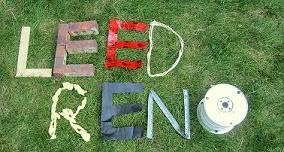 Before this post starts to sound like a lot of CFL bashing, I want to make it clear that I jumped on the CFL bandwagon early. I still remember 8 years ago, shelling out $30 for the 10" long bulbs than took 5 minutes to get to full brightness. And we have a lot of the bulbs in the house.
Before this post starts to sound like a lot of CFL bashing, I want to make it clear that I jumped on the CFL bandwagon early. I still remember 8 years ago, shelling out $30 for the 10" long bulbs than took 5 minutes to get to full brightness. And we have a lot of the bulbs in the house. CFLs became the poster child of the green consumer revolution and for good reason: they kick traditional incadescents' butt. They use 25% of the energy and last 10 times longer. Less energy consumed and less waste generated. But if you want the best technology for the environment (and maybe even your health) that is (or will be) LEDs.
Why? For starter's they are even more energy efficient. The most efficient LEDs can use 1/2 the energy of CFLs. LED light bulbs also last three times longer than CFLs. CFLs boast on average a lifespan of around 8,000 to 15,000 hours, LEDs are closer to 50,000.
But more importantly they have no mercury. All CFLs contain at least 1mg of mercury and most have 3 to 5 mg. May not sound like a lot but last year there was over 100 tons of mercury put into CFL bulbs in the United States alone. So don't throw them in the trash, otherwise all that mercury ends up in the landfill and ultimately the groundwater. CFLs need to be recycled and you can often return them to the store they were purchased at.
To ensure a fair and balanced blog, I will now point out though that in lots of areas the use of a CFL will still result in a net reduction of mercury emissions. Coal power plants have mercury emissions of varying degrees but on average the use of a incandescent bulb for 8000 hours will cause 6mg of mercury emissions. So if you live in an area where the power is generated by coal, a low mercury CFL will reduce our power consumption and could result in a net emission of only 3 or 4mg.
If all of that wasn't enough this week I also came across the following video: "Dirty Electricity". The CBC report by Geeta Nadkarni was part of the "Be Green" series. The report highlights the fact that CFLs induce pulses of high frequency electromagnetic energy in your home electrical system. The concern is that these Electromagnetic fields (EMFs) are getting linked to a wide range of health problems. I am sure there are experts on both sides of that debate but it provides one more advantage in LEDs favour.
Efficiency, lifespan, no hazardous chemicals, and potential health benefits. Sounds like a clear victory for LEDs over CFLs. So our green kitchen is obviously lit purely by LEDs.... right?
err....
ummm...
..... we did just order LED lights for under the cabinets....
 This is the part where our optimism and ideologies met the harsh realities of dealing with emerging technologies. Just like CFLs were bulky, flickered and slow to turn on a half decade ago, the majority of LED bulbs on the market aren't quite performing quite like they should. LEDs turn on instantly but they vary significantly in terms of light output and efficiency. Light output is measure in terms of Lumens, so when buying bulbs try to compare lumen output not the advertized "Wattage Equivalent". I was very diappointed when looking at LED bulbs to find that many said they were 40W equivalents but produced only 50% or 70% of the lumens. Lots of LED bulbs do not even list their lumen output on the package (not very reassuring).
This is the part where our optimism and ideologies met the harsh realities of dealing with emerging technologies. Just like CFLs were bulky, flickered and slow to turn on a half decade ago, the majority of LED bulbs on the market aren't quite performing quite like they should. LEDs turn on instantly but they vary significantly in terms of light output and efficiency. Light output is measure in terms of Lumens, so when buying bulbs try to compare lumen output not the advertized "Wattage Equivalent". I was very diappointed when looking at LED bulbs to find that many said they were 40W equivalents but produced only 50% or 70% of the lumens. Lots of LED bulbs do not even list their lumen output on the package (not very reassuring). Is it the ideal solution? No, but it seemed like the right call for now.

I just finished installed LED's throughout my apartment. Was quite the process but you are right, it's not as bright or clean looking as it used to be... Guess the technology needs a few more years to advance.
ReplyDelete